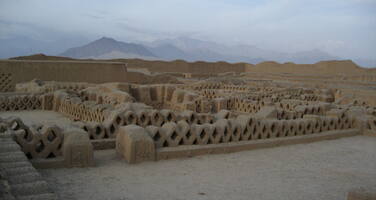Chan Chan Archaeological Zone
Factors affecting the property in 1994*
- Identity, social cohesion, changes in local population and community
- Land conversion
- Other Threats:
Fragility of the abdobe structures
Factors* affecting the property identified in previous reports
- Fragility of its adobe structures;
- Occupation of land by farmers
International Assistance: requests for the property until 1994
Total amount approved : 40,000 USD
| 1994 | Regional and International Course on the Conservation ... (Approved) | 20,000 USD |
| 1987 | Consultancy and equipment for the safeguarding of Chan ... (Approved) | 20,000 USD |
Missions to the property until 1994**
Conservation issues presented to the World Heritage Committee in 1994
The Chan Chan Archaeological Zone was inscribed on the List of World Heritage in Danger in 1986 in view of the fragility of its adobe structures. An extensive monitoring report on the conditions of the site, prepared in the context of the regional monitoring programme for Latin America, was presented to the seventeenth session of the Committee. It was concluded that the conservation and maintenance of the site require continuous efforts as well as the recuperation of the land within the protected area that is presently being occupied by farmers.
In order to carry further the research and training in adobe conservation, the Peruvian authorities have taken the initiative to organize in 1995 a regional/international training course in Chan Chan which will be organized with ICCROM and CRATerre. Parallel to the course, the participants and international experts will also evaluate the conservation practices and experiences in Chan Chan and define new conservation policies. A request for financial assistance for this activity will be presented to the Bureau for approval.
Analysis and Conclusion by World Heritage Centre and the Advisory Bodies in 1994
The Committee is recommended to welcome this initiative and to request the authorities to submit the results of the course and the assessment of the conservation policies and practices to the Secretariat so that recommendations for future actions can be presented at the next session of the Committee. It is recommended that this site be retained on the List of World Heritage in Danger.
Summary of the interventions
Decisions adopted by the Committee in 1994
18 COM IX
SOC: Chan Chan Archaeological Zone (Peru)
Chan Chan Archaeological Zone (Peru)
The Committee welcomed the initiative of the Government of Peru to organise in October 1995, in collaboration with ICCROM and CRATerre, a regional course on the conservation of adobe, parallel to which the participants and international experts would also evaluate the past conservation practices and experiences in Chan Chan and define new conservation policies for this site. The Committee requested the authorities to submit the results of the course and the assessment of the conservation policies and practices to the Secretariat so that recommendations for future actions can be presented at the next session of the Committee. It decided that this site be retained on the List of World Heritage in Danger.
The Committee welcomed the initiative of the Government of Peru to organise in October 1995, in collaboration with ICCROM and CRATerre, a regional course on the conservation of adobe parallel to which the participants and international experts would also evaluate the past conservation practices and experiences in Chan Chan and define new conservation policies for this site. The Committee requested the authorities to submit the results of the course and the assessment of the conservation policies and practices to the Secretariat so that recommendations for future actions can be presented at the next session of the Committee. It decided that this site be retained on the List of World Heritage in Danger.

Exports
* :
The threats indicated are listed in alphabetical order; their order does not constitute a classification according to the importance of their impact on the property.
Furthermore, they are presented irrespective of the type of threat faced by the property, i.e. with specific and proven imminent danger (“ascertained danger”) or with threats which could have deleterious effects on the property’s Outstanding Universal Value (“potential danger”).
** : All mission reports are not always available electronically.

